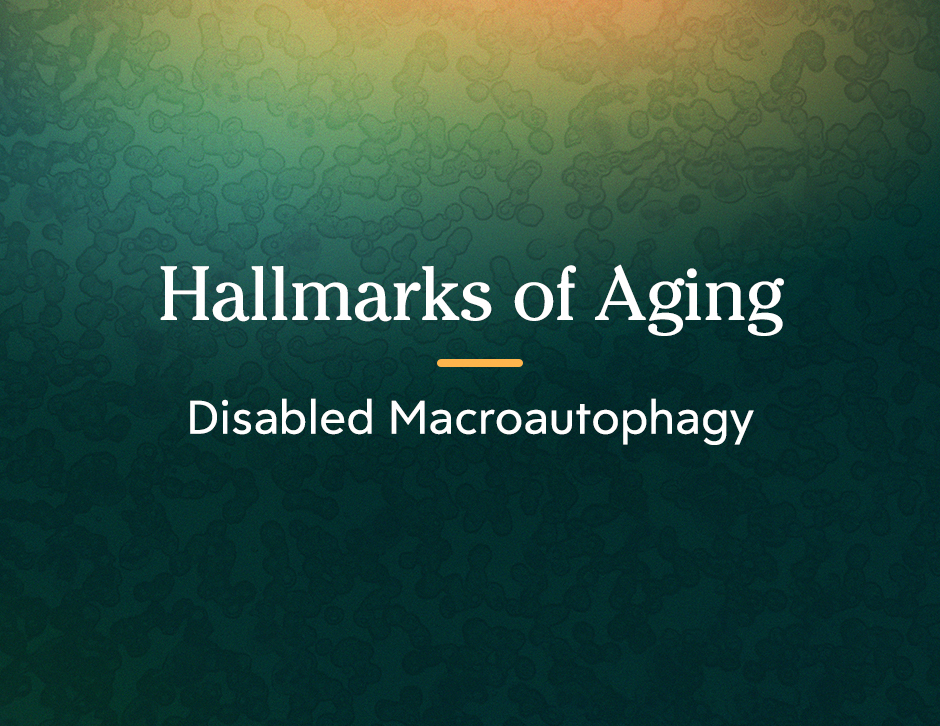
Here’s what we’ll cover in this blog post:
- What is disabled macroautophagy
- How it affects longevity
- What we can do to prevent it
Among the many milestones of longevity science is the hallmarks of aging, a set of biological processes that scientists identified as the roots of biological aging.
Traditional hallmarks include cellular senescence and mitochondrial dysfunction, which drive and accelerate the aging process. Now, scientists have proposed a new hallmark of aging: disabled macroautophagy.
What is macroautophagy?
Autophagy, or macroautophagy, is a cellular process that clears out damaged components in our body, including misfolded proteins and zombie cells. These damaged components are then recycled into energy for our cells, and replaced with new, functional components.
If we think of our body as a vehicle, then autophagy is like our own built-in mechanic: when an old component breaks down, autophagy replaces it with a new one.
Autophagy is a crucial part of what keeps us healthy and functioning. When this system runs efficiently, it helps our cells run efficiently.
But as we age, this process becomes increasingly impaired, and as a result, our cells become less efficient, with more and more damaged cells building up in our organs. As cellular damage accumulates, so does the progression of age-related disease.
Why is disabled macroautophagy bad?
Our cells depend on autophagy to maintain proper function. Disabled macroautophagy disrupts our cellular homeostasis—a process that normally keeps our cells stable. When this happens, damage accumulates and eventually carries over to our organs and other tissues.
Think of a car that hasn’t been to the shop in a while. If our built-in mechanic isn’t working properly, rust and other damage starts to build up on its parts. As enough rust and damage accumulates, those parts eventually stop working.
Similarly, enough damaged cells can damage the surrounding tissues and organs, leaving us susceptible to age-related diseases.
But autophagy is also vital for energy maintenance. Those recycled parts are recycled for a reason: to produce cellular energy and maintain metabolic balance. As autophagy declines, we may notice reduced energy and symptoms of metabolic syndrome, which can lead to age-related diseases like diabetes.
How does disabled macroautophagy happen?
Disabled macroautophagy happens primarily when damaged cells outpace our autophagy system’s ability to recycle them.
Processes that can slow autophagy include:
- mTOR disruption
mTOR, or the mechanistic target of Rapamycin, is a key enzyme that blocks autophagy. If the mTOR pathway is on, it can stop autophagy. Though this can keep our autophagic processes in check, the mTOR pathway can also prevent autophagy for too long, allowing damaged parts to accumulate. - Metabolic imbalance
Insulin and glucose help keep our autophagic processes functioning optimally. Developing insulin resistance or maintaining chronically high glucose levels can disrupt the balance that keeps autophagy going. - Epigenetic alterations
Epigenetics are like chemical marks that act as volume knobs for our genes, controlling how loudly or softly they’re expressed. Genes like autophagy-related genes (ATGs) help regulate autophagy. As our epigenetics are altered, we start to lose control of the volume knob for these genes, reducing autophagic activity. - Chronic inflammation
Chronic age-related inflammation, or inflammaging, occurs when the inflammatory process persists for months or years. This process damages tissues and interferes with many biological processes, including autophagy.
How can I prevent disabled macroautophagy?
Though autophagy happens on a cellular level, there are several simple, science-backed solutions for boosting autophagy and slowing down the aging process:
- Intermittent fasting or caloric restriction
Stress signals like hunger can activate autophagy by signaling nutrient scarcity. Limiting our nutrient intake also gets us one step closer to optimizing the metabolic processes that keep autophagy going and limiting chronic inflammation that slows autophagy down. - Exercise
Physical activity is another stress signal that promotes autophagy in muscles and other tissues. Like caloric restriction, exercise also promotes metabolic health and reduces inflammation. - Rapamycin
Rapamycin’s primary mechanism of action is inhibiting the mTOR pathway. In fact, mTOR gets its name from Rapamycin! Inhibiting mTOR may have diverse longevity benefits, but it also prevents deregulation of mTOR signaling, which may induce autophagy.
What if I don’t know where to start?
Even with the tools above at your disposal, it can be hard knowing which tool to choose when your internal mechanic is on a break. That’s why we’re here to help select the tool that’s right for you.
Starting with a longevity consultation can help provide a clear picture of your overall health and longevity directly from a licensed medical expert, so you know where to focus your efforts. If appropriate, your longevity consultant may recommend Rapamycin.
With these tools in your longevity toolkit, you’re one step closer to optimizing the biological processes involved in aging, so you can enjoy a longer, healthier life.
Note: The above statements have not been evaluated by the Food and Drug Administration. This product is not intended to diagnose, treat, cure, or prevent any disease.
